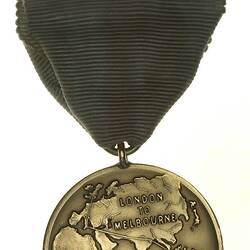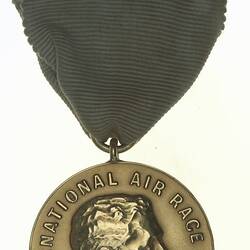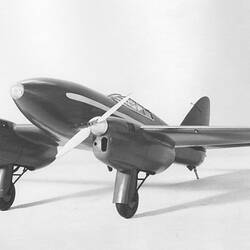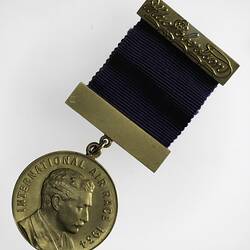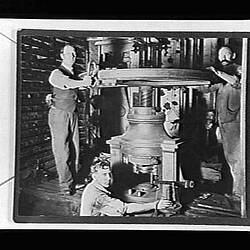Summary
Gold medal awarded to Charles James Melrose, the only Australian pilot to win a prize in the Melbourne Centenary Air Race.
The Melbourne Centenary Air Race, also known as the MacRobertson International Air Race, was held in October 1934, to commemorate the Centenary of the establishment of Melbourne and the first European settlement of Victoria.
Staged over several days with intermediate stops at Baghdad, Allanhabad, Singapore, Darwin and Charleville, the race was by far the longest distance air endurance event held up to that time and drew worldwide attention, due in a large part to the lucrative £10,000 prize and trophy donated by Melbourne's confectionary king, Sir MacPherson Robertson.
Charles James (Jimmy) Melrose was the youngest competitor and the only Australian pilot to win a prize. Piloting a single-engined de Havilland DH 80A Puss Moth, named My Hildergarde after his mother and key sponsor, Melrose completed the race in 9 days 7 hours and 16 minutes, sufficient to gain him third place and a prize of £1,000 in the handicap section.
The Melbourne Centenary Air Race, also known as the MacRobertson International Air Race, was held in October 1934, to commemorate the Centenary of the establishment of Melbourne and the first European settlement of Victoria. Staged over several days with intermediate stops at Baghdad, Allahabad, Singapore, Darwin and Charleville, the race was by far the longest distance air endurance event held up to that time and drew worldwide attention, due in a large part to the lucrative £10,000 prize and trophy donated Melbourne's confectionary king, Sir MacPherson Robertson. Leading British and American aircraft manufacturers including de Havilland, Boeing and the Douglas Aircraft Co entered examples of their latest aircraft, all keen to proof their speed and capabilities for long-distance flight. On 20 October 1934, a crowd of 60,000 spectators gathered at Mildenhall Air Base in England to watch the ballot for race order and subsequent departure of the 20 competing aircraft at 45 second intervals. On 23 October 1934, a crowd of 40,000 people gathered at Flemington Racecourse to watch the race leader de Havilland DH 88 Comet, Grosvenor House, piloted by C.W.A. Scott And T. Campbell Black pass overhead before landing at Laverton. They had completed the 11,300 mile (18,000 km) flight in just 71 hours 1 min (including refuelling landings), at an average speed of 3,480 miles (5,570 km) per day. Charles James (Jimmy) Melrose was the youngest competitor and the only Australian pilot to win a prize. Piloting a single-engined de Havilland DH 80A Puss Moth, named My Hildergarde after his mother and key sponsor, Melrose completed the race in 9 days 7 hours and 16 minutes, sufficient to gain him third place and a prize of £1,000 in the handicap section. Only nine planes completed the race within the allocated 2-week period, but the event was an enormous public success and an achievement with far reaching impacts. It proved the practical potential of the long-distance England to Australia air route, contributing to the establishment of regular aerial mail & passenger services on the route in 1938. In addition manufacturers like the Douglas Aircraft Co, who built the DC-2 Royal Dutch Airlines plane, PH-AJU Uiver that came second, were inundated with orders for their revolutionary all-metal aircraft from airlines around the world.
Charles James Melrose was born on 13 September 1913 at Burnside, Adelaide, the only child of pastoralist James Melrose and his second wife Hilda Westley. Melrose was an early member of the (Royal) Aero Club of South Australia, based at Parafield, gaining his pilot's licence at 19. His widowed mother was his first passenger. Influenced by her enthusiasm and his English aviator uncle, Noel Pemberton Billing, Melrose purchased a DH Puss Moth fitted with a powerful 120 horsepower (89 kW) Gipsy Major engine. In August 1934 he flew the plane in a record-breaking 8,000 mile (12,875 km) solo flight around Australia, before flying it to England to compete in the race. He was the only competitor to fly solo. In 1935 he studied navigation and blind flying in England before returning to Australia in a new Percival Gull, with which he joined in the unsuccessful search for Sir Charles Kingsford Smith. Melrose himself died less than a year later when his plane disintegrated over South Melton in adverse weather on 5 July 1936, while on a charter flight from Melbourne to Darwin.
All competitors who completed that race within the allocated 2-weeks were presented with a gold medallion struck by Stokes & Sons, Melbourne. The Museum holds a model of the de Havilland DH-88 Comet, 'Grosvenor House', that won the race [ST 020065] and an example of the uninscribed commemorative medal [NU 42206]
Physical Description
18 carat gold medal, with gilt bar and white ribbon. The ribbon is discoloured. The bar has the MacRobertson signature.
Obverse Description
Bust of Sir MacPherson Robertson facing right wearing suit and tie; around, INTERNATIONAL AIR RACE 1934 in small letters on truncation, STOKES
Reverse Description
Map showing route of Air Race from London to Melbourne, over Asia, LONDON / TO / MELBOURNE; on Indian Ocean, 1934 / 1935. In small letters at lower edge, 18C
Edge Description
Plain
More Information
-
Collecting Areas
Numismatics & Philately, Public Life & Institutions, Transport
-
Acquisition Information
Purchase
-
Date Issued
1934 AD
-
Issued By
-
Mint
Stokes & Sons, Melbourne, Greater Melbourne, Victoria, Australia, 1934
-
Date of Event
-
Awarded To
-
Person Depicted
Sir MacPherson Robertson - MacRobertson Pty. Ltd., Victoria, Australia, 1934
-
Series
-
Material
Gold
-
Axis
12
-
Classification
-
Category
-
Discipline
-
Type of item
-
Overall Dimensions
40 mm (Width), 80 mm (Height), 32.38 g (Weight)
-
Overall Dimensions
35 mm (Outside Diameter)
-
Shape
Round with loop, bar and ribbon
-
Keywords
Air Races, Celebrations, Centennial Air Race, London to Melbourne, 1934, Flights, Melbourne Centenary, 1935, Victoria Centenary, 1934-1935

